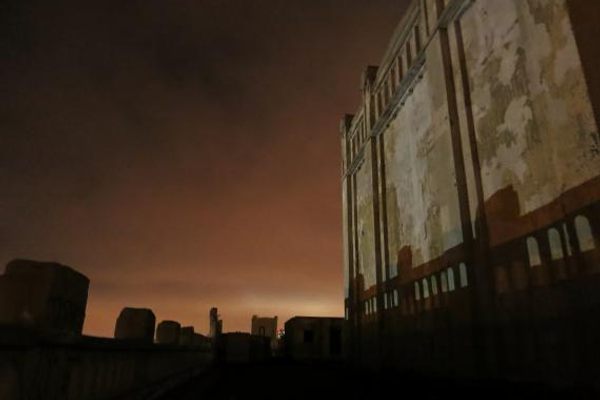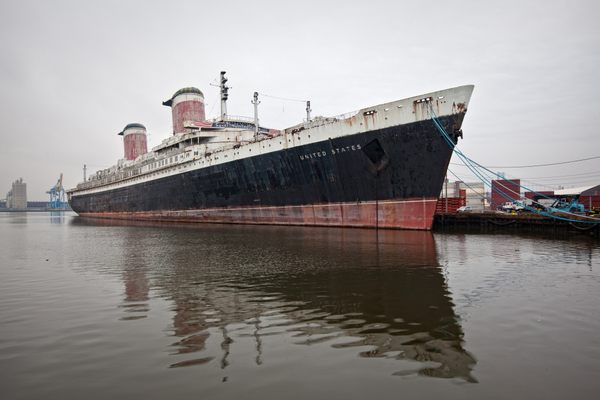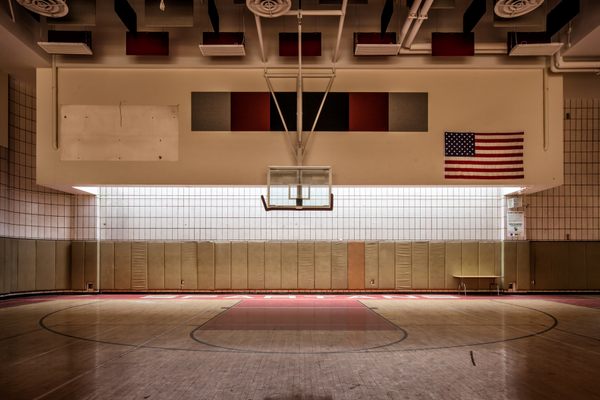Catching the View Before the Condos on Two Red Hook Warehouses
Daylight finds its way under the netting (all photographs by the author)
Two sister shipping warehouses — 60 and 62 Imlay Street — sit complacently on the Brooklyn waterfront, hulking over Red Hook’s industrial wasteland as relics of yesteryear’s harbor.
Rooftop views from 160 Imlay Street
Built in 1913, the identical twin loft buildings were made as storehouses for the New York Dock Company, a massive network of 200 warehouses and 39 piers for a total of 65,000,000 cubic feet extending over three miles of the Brooklyn waterfront. Dock workers populated the booming wharfs, shuffling shipments of cotton, tobacco, sugar, grain, and coffee up and down the six flights of regimented shafts which pervade the buildings’ interiors.
Historic photograph of the warehouses
By 1983 the building was antiquated, the infrastructure outdated, the industry dying, profits declining, and thus all operations came to a halt at 160 and 62 Imlay. Their once-thriving state-of-the-art structures were left to the elements, and oh, what they did with the place. Wind, rain, and time ripped out all but the bare bones of the buildings; black netting now veils derelict structures, each of their sprawling floors impressive for their total vacancy, their purely empty state, immaculate but for decay.
This sign once read “E.J. Trum”
20 years later, in 2003, developer Bruce Batkin bought both warehouses for $22 million, planning to convert them into 150 residential apartments. A long lawsuit followed regarding a variance by a Red Hook coalition that opposed the project on the grounds that it would kill the neighborhood’s industrial character. By 2009, two Supreme Court rulings later, Batkin washed his hands of the project, which was quickly bought out by Bruce Federman, who plans to convert 160 Imlay into luxury condos and artist studios.
Sunlight through the windows
62 Imlay, on the other hand, has since been transformed into the upscale auction house Christie’s storage, with multimillion dollar artworks, manuscripts, furniture, and rare cars (many of the pieces are worth more than the building itself). Works by Vincent van Gogh, Constantin Brâncuși, and Jackson Pollock are protected by infrared video cameras, biometric readers, motion activated monitors, and smoke, heat, and water detection systems — a security program worthy of James Bond, but completely hidden behind a windowless front.
Historic image of the Imlay warehouses
After years of legal battles and stalling, it would seem that plans for 160 Imlay are now being acted on, as lights have recently been turned on inside, illuminating the empty goliath, new fencing has been put up, ground floor walls are being knocked in, and workers’ tools have begun filling the floors. Designs aim to convert the long-abandoned two-story water tower on the building’s roof into a penthouse garden, and the exterior will remain largely as it is.
Yet the signs of visitors are already in the building. Red Solo cups are strewn throughout a first floor conference room; graffiti adorns the walls throughout the building; shards of shattered beer bottles are scattered about the roof and the truck depot behind the building; improvised rope ladders have been tied to taller structures on the roof; melted down candles sit ashen in impromptu holders. And then there are the stories: a boy once fell 50 feet from the will-be rooftop penthouse (luckily surviving with a compound fracture); some have climbed 30 feet of rusted ladder with 40s taped to their hands, and great feats of climbing, drunkenness, and hooligan behavior have generally transpired behind the ratty netting in this briefly forgotten muddle of shaftways and pillars, a ruffian playground.
Sunrise over the city that never sleeps
View from the Manhattan side
Inside the soon-to-be penthouse
Warehouse shenanigans tonight?
Moonlight illuminates the scaffolding
Sunset
Clouds above the warehouses
During construction circa 1912
Stone doesn’t fade, and the New York Dock Company logo is still clearly visible
RED HOOK WAREHOUSE, Brooklyn, New York














Follow us on Twitter to get the latest on the world's hidden wonders.
Like us on Facebook to get the latest on the world's hidden wonders.
Follow us on Twitter Like us on Facebook